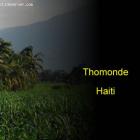The City of Fort-Liberté, Haiti to be Tsunami Ready
ADVERTISEMENT
In 2017, the Caribbean Tsunami Information Centre (CTIC) of UNESCO's Intergovernmental Oceanographic Commission (IOC) took important steps to improve early warning systems, public awareness and preparedness in the region. The Kingdom of Netherlands provided a contribution of €80,000 on this account.
'Tsunami' is a Japanese term meaning wave 'nami' in a harbor 'tsu'. Tsunamis are a series of long waves of extremely long length and period, usually generated by disturbances associated with earthquakes occurring below or near the ocean floor. The tsunami waves can reach enormous dimensions and travel across entire ocean basins with little loss of energy. Tsunami wave travels as fast as a modern jet airliner - up to 800 km/h. Generally, if an earthquake is over 6.5 on Richter scale and is happening at between 0 and 5 kilometers depth beneath the sea floor, the monitors set up to record earthquakes around the planet can send out a tsunami warning.
Some of the criteria to get Tsunami Ready label, are: (a) Schools, playgrounds, hospitals, factories and homes should not be built in areas vulnerable to tsunamis; (b) A 24-hour warning point and emergency operations center; (c) Have more than one way to receive tsunami warnings and to alert the public; (d) Have more than one way to receive tsunami warnings and to alert the public; (e) Promote public readiness through community education and the distribution of information; (f) Develop a formal tsunami plan, which includes holding emergency exercises.
Read more: Fort-Liberte Bay, Tsunami, Energy Environment
« Potentially deadly tsunamis threaten the Caribbean | Main | Tips for Tsunami »
Leave a Reply
Name (required) E-mail (required, will not be published)
» »
Our objective is to share with you news and information about Haiti and the people of Haiti. Traditions, habits and the way we were or grew are alive in this site. We highly recommend that you Subscribe to our Newsletter and also share with us some of the things that are memorable and made us unique people.


 Black Friday Shopping Season
Black Friday Shopping Season  Thomonde, Haiti
Thomonde, Haiti  Haiti tech Summit
Haiti tech Summit  Haitian Creole Translation
Haitian Creole Translation  Newsletter
Newsletter